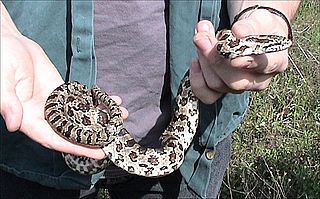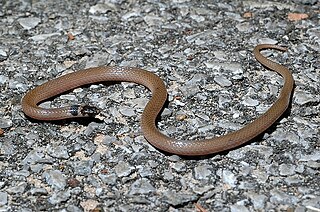
Pantherophis obsoletus, also known commonly as the western rat snake, black rat snake, pilot black snake, or simply black snake, is a nonvenomous species of snake in the family Colubridae. The species is native to central North America. There are no subspecies that are recognized as being valid. Its color variations include the Texas rat snake. Along with other snakes of the eastern United States, like the eastern indigo snake and the eastern racer, it is called “black snake”.

Tantilla melanocephala, commonly known as the black-headed snake or neotropical black-headed snake, is a species of small colubrid snake endemic to Central America and South America.

Oligodon is genus of colubrid snakes that was first described by Austrian zoologist Leopold Fitzinger in 1826. This genus is widespread throughout central and tropical Asia. The snakes of this genus are commonly known as kukri snakes.

Tantilla is a large genus of harmless New World snakes in the family Colubridae. The genus includes 66 species, which are commonly known as centipede snakes, black-headed snakes, and flathead snakes.

Lampropeltis calligaster is a species of kingsnake known commonly as the prairie kingsnake or yellow-bellied kingsnake.

Tantilla hobartsmithi, commonly known as the southwestern blackhead snake, is a species of small colubrid snake native to the southwestern United States and northern Mexico.

The Florida crowned snake is a species of colubrid snake found in Florida and Georgia. It is a small, slender, non-venomous snake that is rarely seen. The species is commonly found in north and central Florida, and is most often associated with sandy habitats.

The southeastern crown snake is a common species of small colubrid snake endemic to the southeastern United States.
The rim rock crowned snake, named after the Miami Rim Rock land arrangement, is a non-venomous endangered species of snake belonging to the family Colubridae. The rim rock crowned snake is endemic to the United States throughout southern Florida. The specific name, oolitica, refers to the oolitic limestone area of Florida in which the species is found. All species of snakes that belong to the genus Tantilla, are relatively small and usually do not exceed 20 cm (8 in). The species T. oolitica was added to the IUCN Red List in 2007 as a result of loss in habitat and restricted range.

The short-tailed snake is a small harmless colubrid snake. Fossorial and seldom seen, it is found only in sandy, upland parts of Florida where it is listed as Threatened and is protected by state law.
Lycodon chrysoprateros, also known as Ross's wolf snake, is a species of colubrid snake found on the island of Dalupiri in the Philippines.

Scolecophis is a genus of snake in the family Colubridae that contains the sole species Scolecophis atrocinctus. Its genus name is derived from Greek: skolex meaning a worm or grub and ophis meaning snake, referring to what it likes to eat. Its species name is derived from Latin ater meaning black and cingula meaning girdle referring to its physical appearance. It is commonly known as the black-banded snake.

Tantilla gracilis is a species of snake of the family Colubridae.

Tantilla alticola, Boulenger's centipede snake, is a species of snake of the family Colubridae.
Tantilla andinista, the Andes centipede snake, is a species of snake of the family Colubridae.
Tantilla johnsoni, also known commonly as Johnson's centipede snake and la culebra centipedívora de Chiapas in Mexican Spanish, is a species of snake in the subfamily Colubrinae of the family Colubridae. The species is endemic to Mexico.
Tantilla supracincta, the banded centipede snake, is a species of snake of the family Colubridae.












